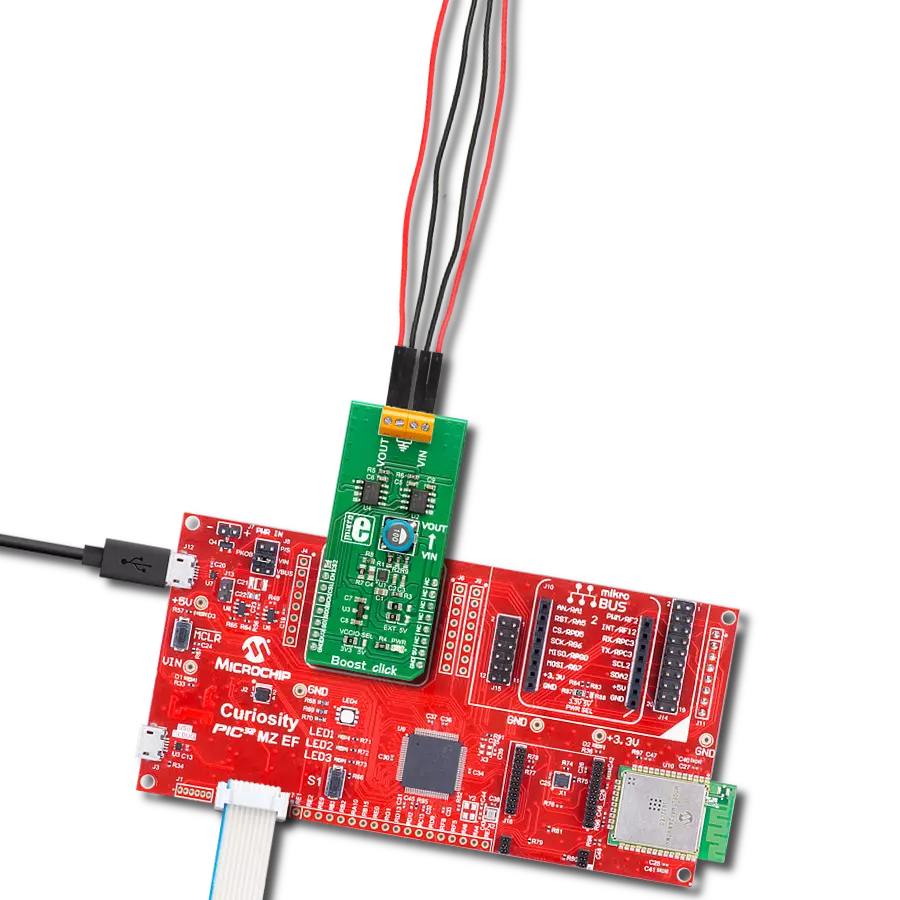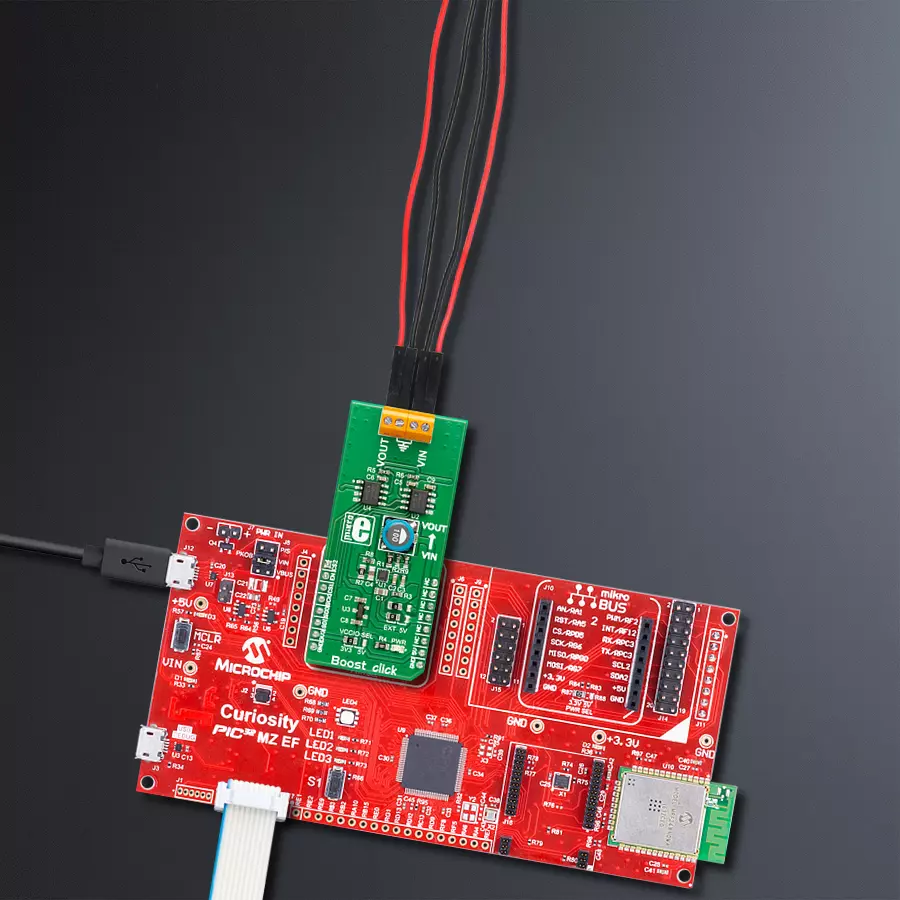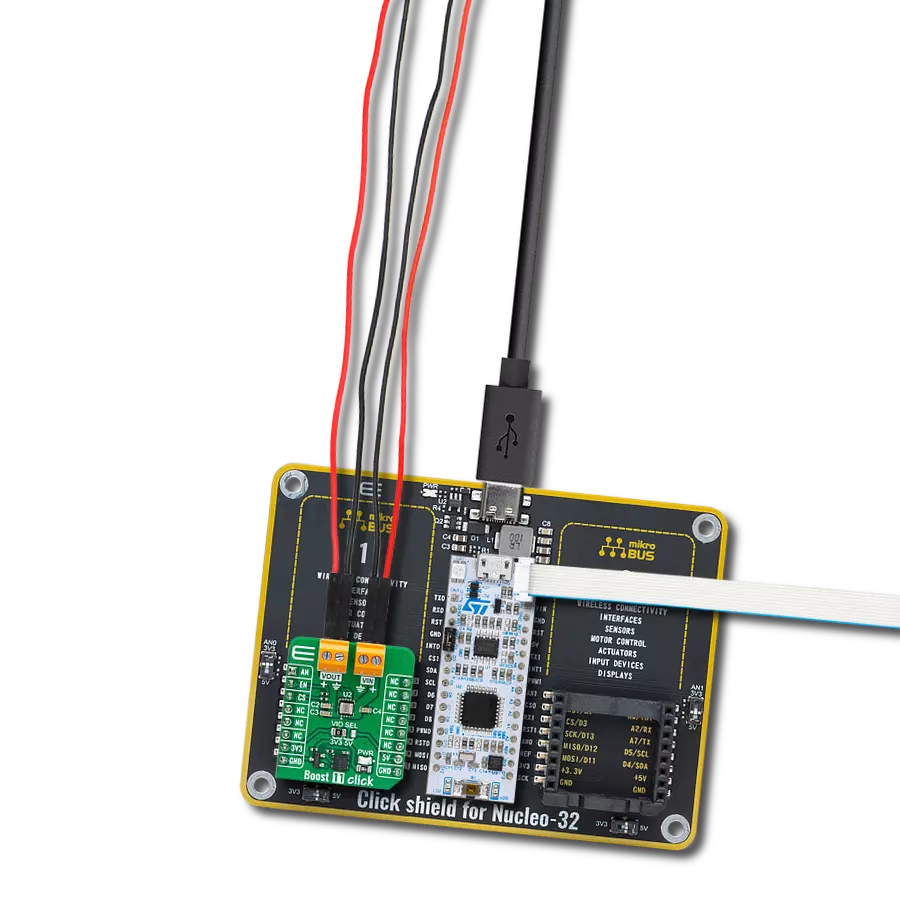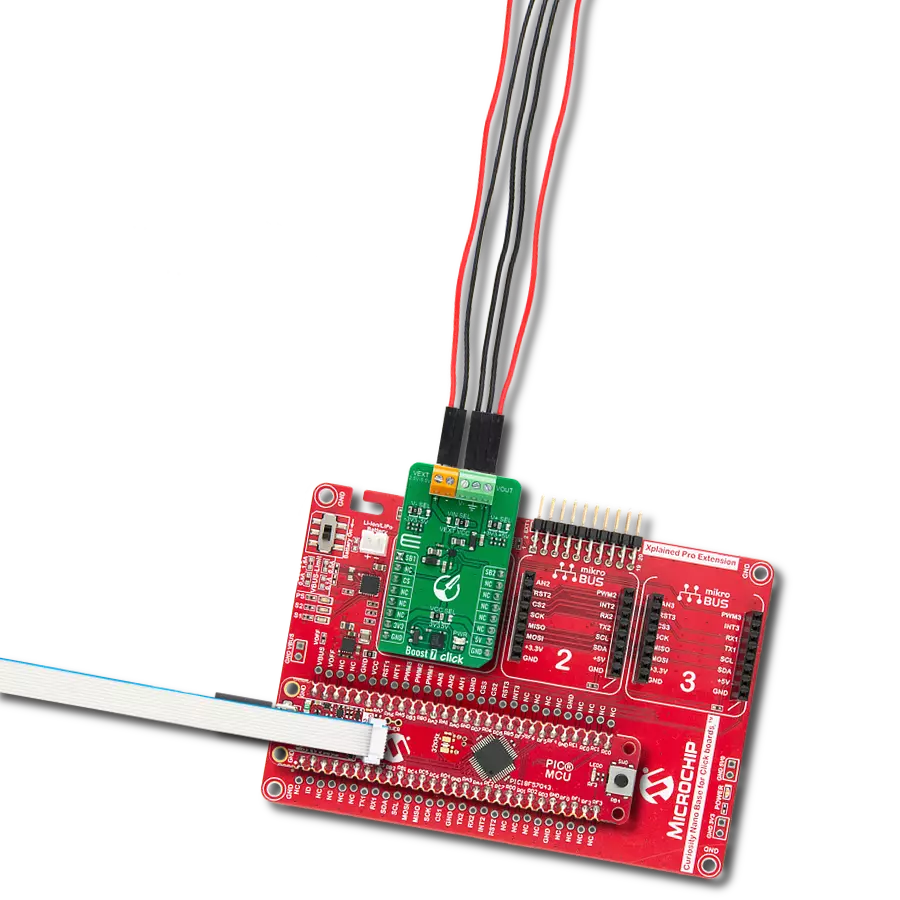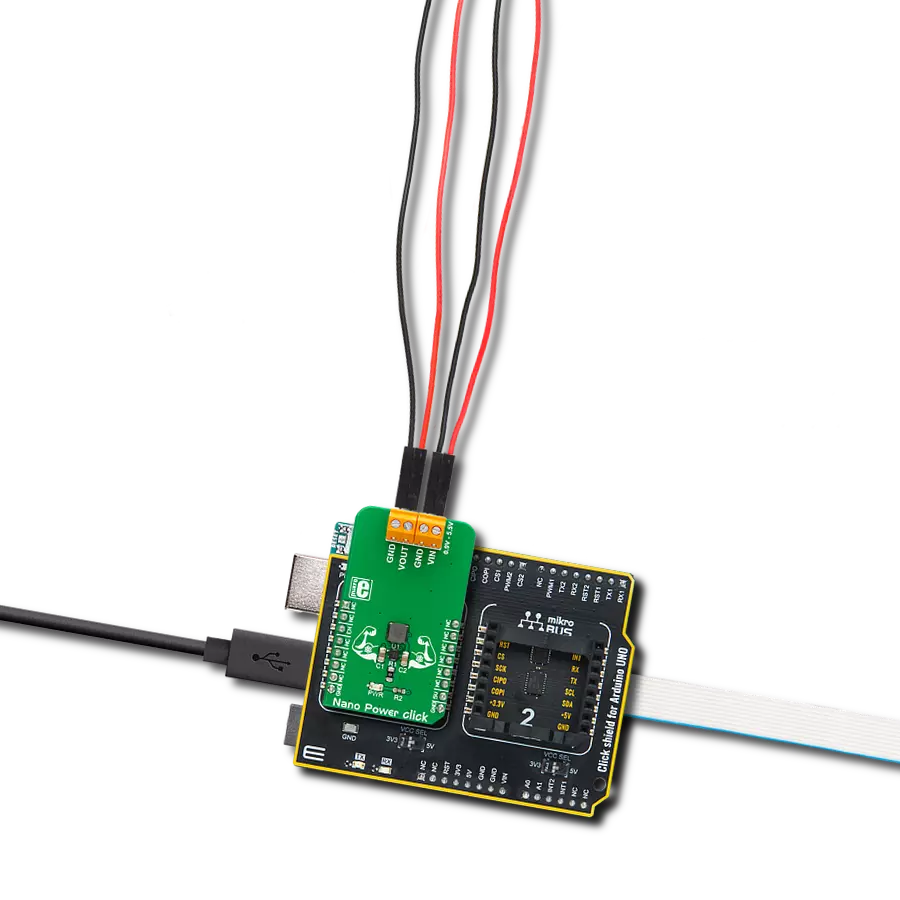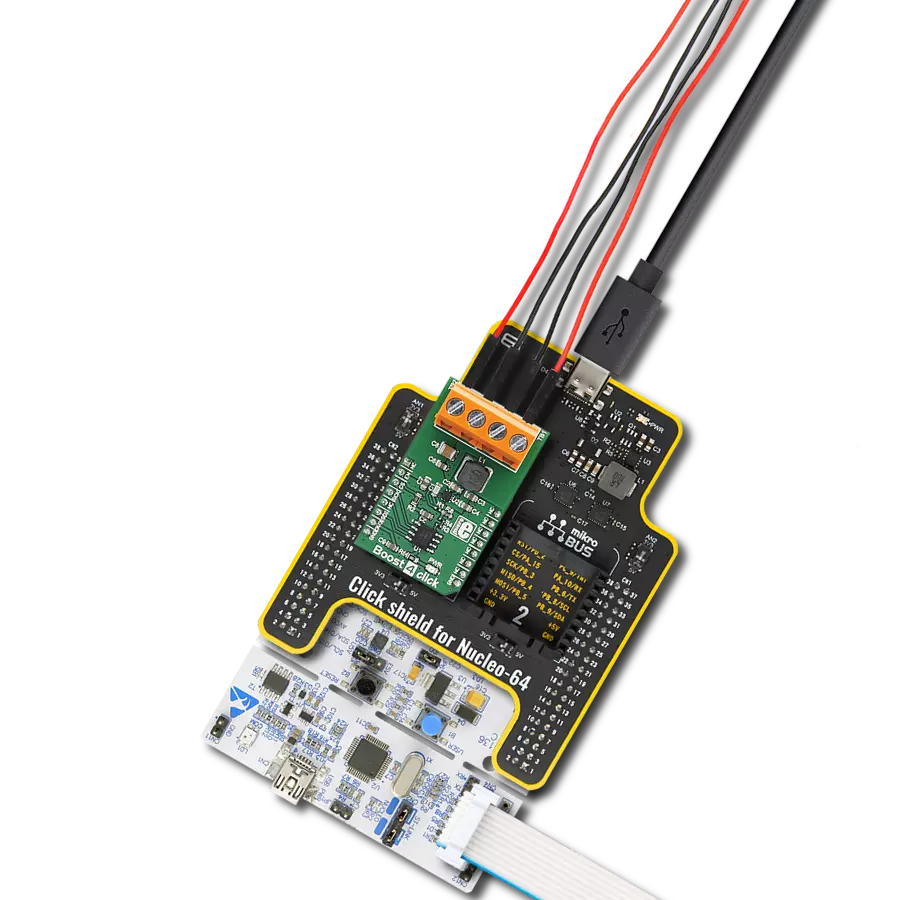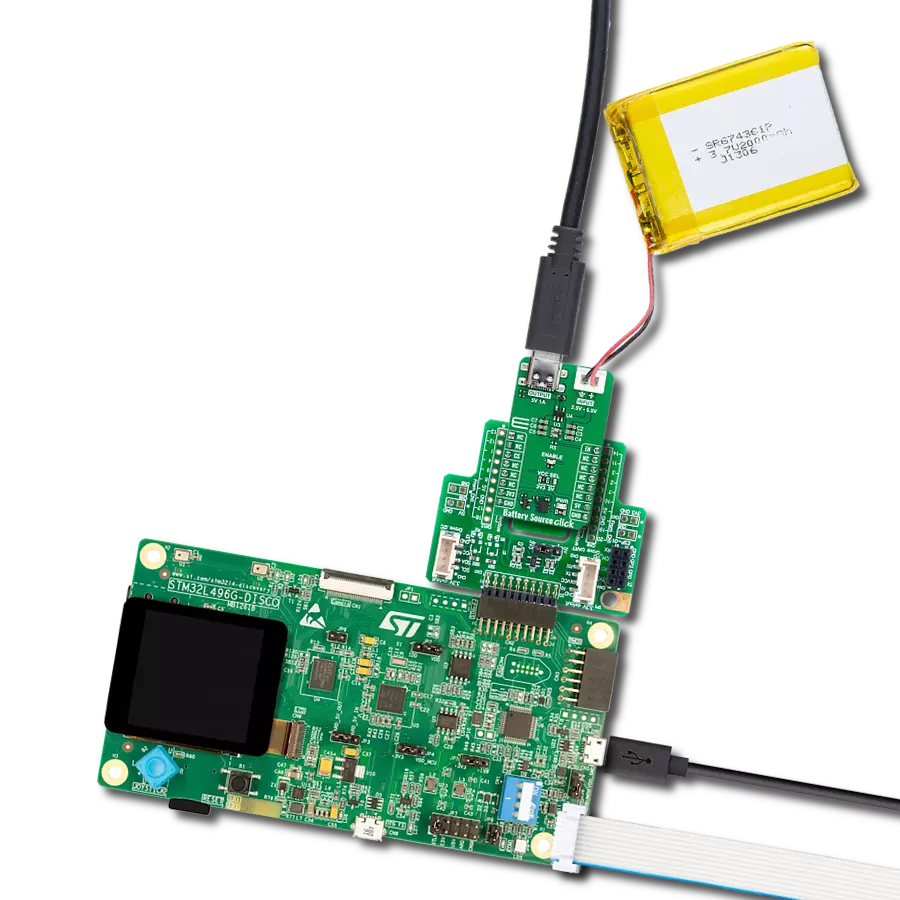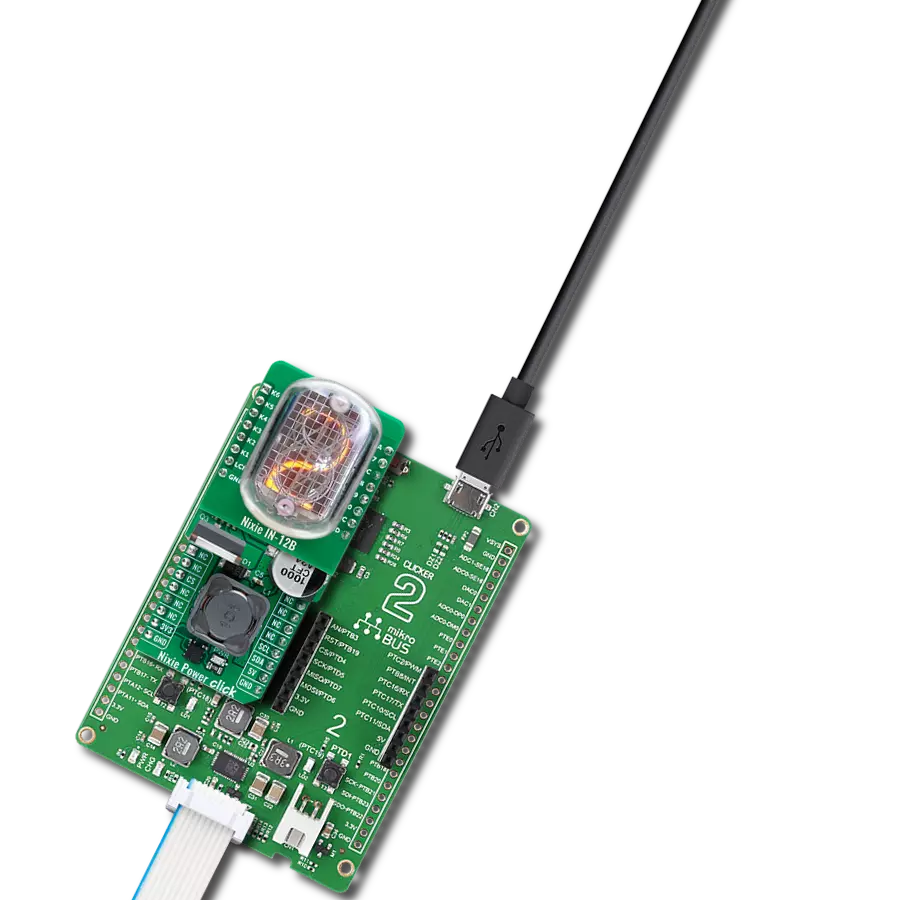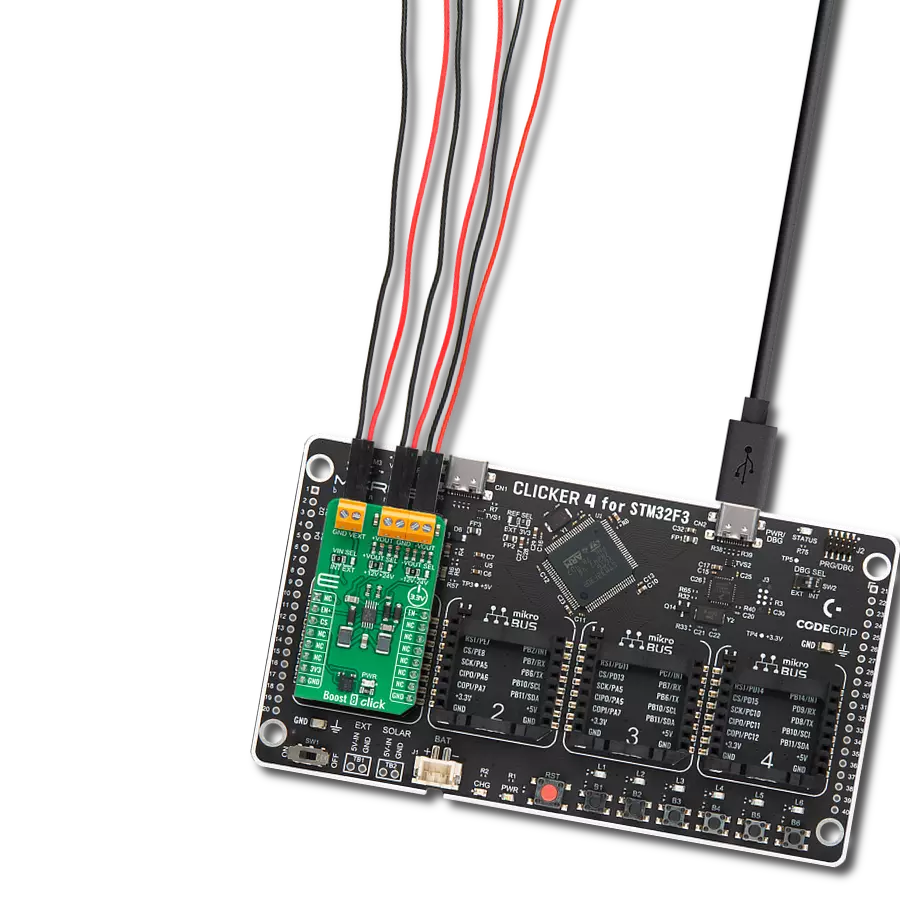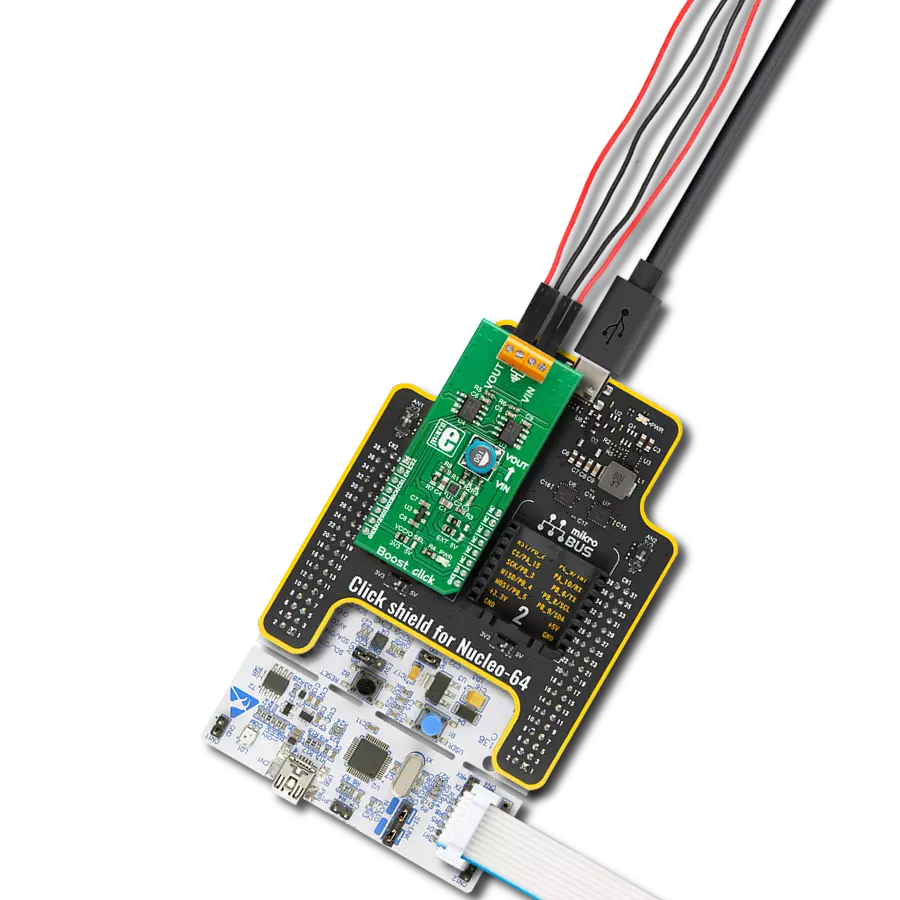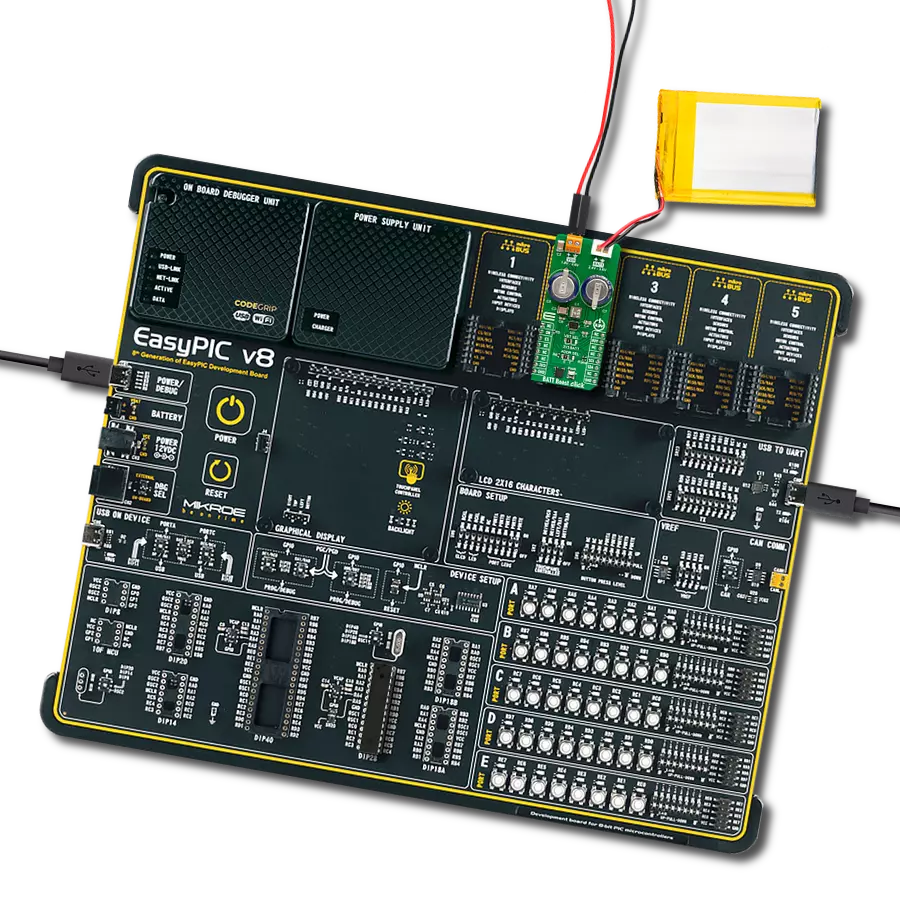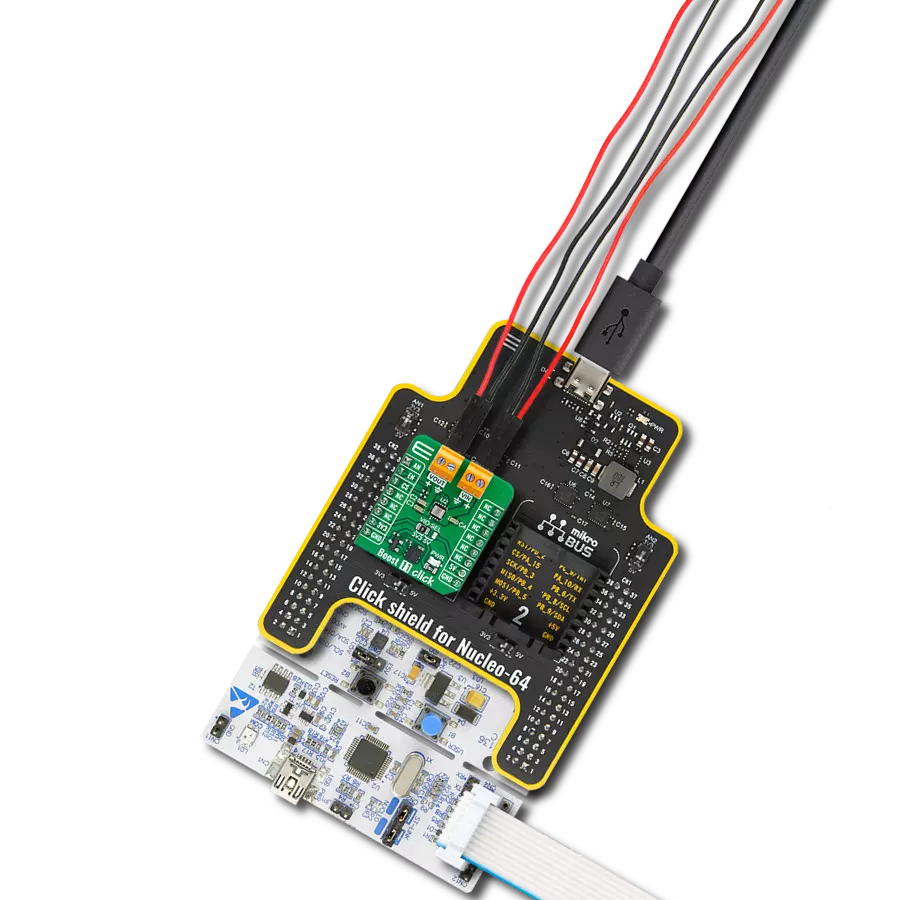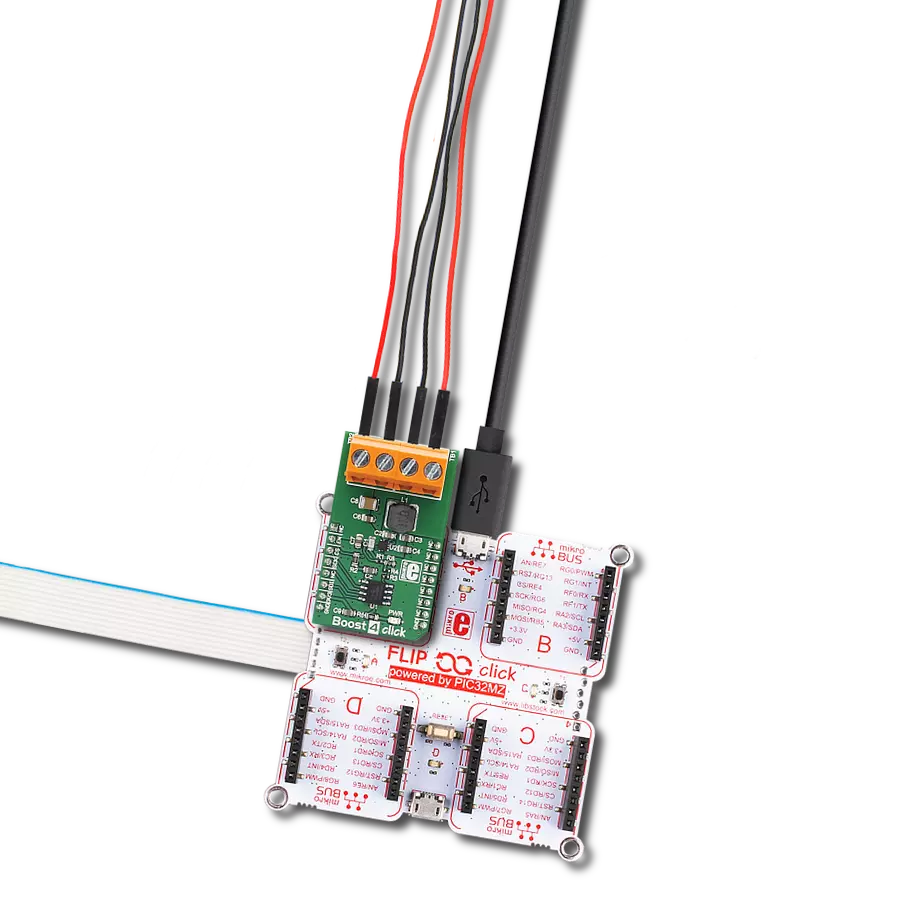利用我们的电压升压解决方案,释放您以下项目的全部潜力。
A
A
硬件概览
它是如何工作的?
Boost Click基于MIC2606,这是一款0.5A、2MHz宽输入范围升压稳压器,集成了开关和肖特基二极管,来自Microchip。其FB(反馈)引脚提供了控制输出的控制路径。这个FB引脚由板载DAC(MCP4921)驱动。这是一款2.7 - 5.5V的低功率、低DNL、12位串行数字模拟转换器(DAC),具有SPI接口。它为
工业应用提供了高精度和低噪声性能。输出电压通过电压分压器连接到板载ADC,即MCP3551,它是一款2.7V至5.5V的低功率、22位增量-Σ模数转换器。输入电压可以从mikroBUS™设置为5V,也可以从连接到VIN螺钉端子的外部DC源设置为7-20V。输出电压可以设置为高达38V。ADC和DAC的参考电压
由MAX6106提供 - 板载电压参考。该Click板可以通过VCCIO SEL跳线选择3.3V或5V逻辑电压电平操作。这样,既能支持3.3V又能支持5V的MCU可以正确使用通信线。然而,该Click板配备了一个包含易于使用的函数和示例代码的库,可用作进一步开发的参考。
功能概述
开发板
Curiosity PIC32 MZ EF 开发板是一个完全集成的 32 位开发平台,特点是高性能的 PIC32MZ EF 系列(PIC32MZ2048EFM),该系列具有 2MB Flash、512KB RAM、集成的浮点单元(FPU)、加密加速器和出色的连接选项。它包括一个集成的程序员和调试器,无需额外硬件。用户可以通过 MIKROE
mikroBUS™ Click™ 适配器板扩展功能,通过 Microchip PHY 女儿板添加以太网连接功能,使用 Microchip 扩展板添加 WiFi 连接能力,并通过 Microchip 音频女儿板添加音频输入和输出功能。这些板完全集成到 PIC32 强大的软件框架 MPLAB Harmony 中,该框架提供了一个灵活且模块化的接口
来应用开发、一套丰富的互操作软件堆栈(TCP-IP、USB)和易于使用的功能。Curiosity PIC32 MZ EF 开发板提供了扩展能力,使其成为连接性、物联网和通用应用中快速原型设计的绝佳选择。
微控制器概述
MCU卡片 / MCU

建筑
PIC32
MCU 内存 (KB)
2048
硅供应商
Microchip
引脚数
100
RAM (字节)
524288
使用的MCU引脚
mikroBUS™映射器
“仔细看看!”
Click board™ 原理图

一步一步来
项目组装
软件支持
库描述
这个库包含了Boost Click驱动程序的API。
关键函数:
boost_write_byte- 通用写入14位数据函数boost_read_byte- 通用读取22位数据函数boost_set_configuration- 设置配置函数
开源
代码示例
完整的应用程序代码和一个现成的项目可以通过NECTO Studio包管理器直接安装到NECTO Studio。 应用程序代码也可以在MIKROE的GitHub账户中找到。
/*!
* \file
* \brief Boost Click example
*
* # Description
* Boost Click provides an adjustable output voltage through the onboard DAC that drives the FB
* pin of the MIC2606 to set desired output voltage.
*
* The demo application is composed of two sections :
*
* ## Application Init
* Initializes SPI driver for serial communication and puts the device to power ON state.
* Also, initializes logger module for message and results sending.
*
* ## Application Task
* This is a example which demonstrates the use of Boost Click board.
* Boost Click communicates with register via SPI by reading from MCP3551 chip and writing DAC value to the MCP4921 chip.
* This example periodicaly increases and decreases voltage in range between 15 and 30 Volts.
* All data logs write on usb uart for aproximetly every 1 sec.
*
*
* \author Nemanja Medakovic
*
*/
// ------------------------------------------------------------------- INCLUDES
#include "board.h"
#include "log.h"
#include "boost.h"
// ------------------------------------------------------------------ VARIABLES
static boost_t boost;
static log_t logger;
// ------------------------------------------------------ APPLICATION FUNCTIONS
void application_init ( void )
{
log_cfg_t log_cfg;
/**
* Logger initialization.
* Default baud rate: 115200
* Default log level: LOG_LEVEL_DEBUG
* @note If USB_UART_RX and USB_UART_TX
* are defined as HAL_PIN_NC, you will
* need to define them manually for log to work.
* See @b LOG_MAP_USB_UART macro definition for detailed explanation.
*/
LOG_MAP_USB_UART( log_cfg );
log_init( &logger, &log_cfg );
log_info( &logger, "---- Application Init... ----" );
boost_cfg_t boost_cfg;
// Click initialization.
boost_cfg_setup( &boost_cfg );
BOOST_MAP_MIKROBUS( boost_cfg, MIKROBUS_1 );
if ( boost_init( &boost, &boost_cfg ) == BOOST_ERROR )
{
log_info( &logger, "---- Application Init Error. ----" );
log_info( &logger, "---- Please, run program again... ----" );
for ( ; ; );
}
log_info( &logger, "---- Application Init Done. ----" );
boost_device_enable( &boost );
log_info( &logger, "---- Application Running... ----\n" );
}
void application_task ( void )
{
for ( uint16_t dac_value = 0; ; dac_value += 100 )
{
if ( boost_dac_write( &boost, dac_value ) == BOOST_ERROR )
{
break;
}
log_printf( &logger, " DAC value [12-bit] : %u\r\n", dac_value );
Delay_ms ( 1000 );
log_printf( &logger, " VOUT value [V] : %.3f\r\n\n", boost_vout_read( &boost ) );
Delay_ms ( 1000 );
}
}
int main ( void )
{
/* Do not remove this line or clock might not be set correctly. */
#ifdef PREINIT_SUPPORTED
preinit();
#endif
application_init( );
for ( ; ; )
{
application_task( );
}
return 0;
}
// ------------------------------------------------------------------------ END
